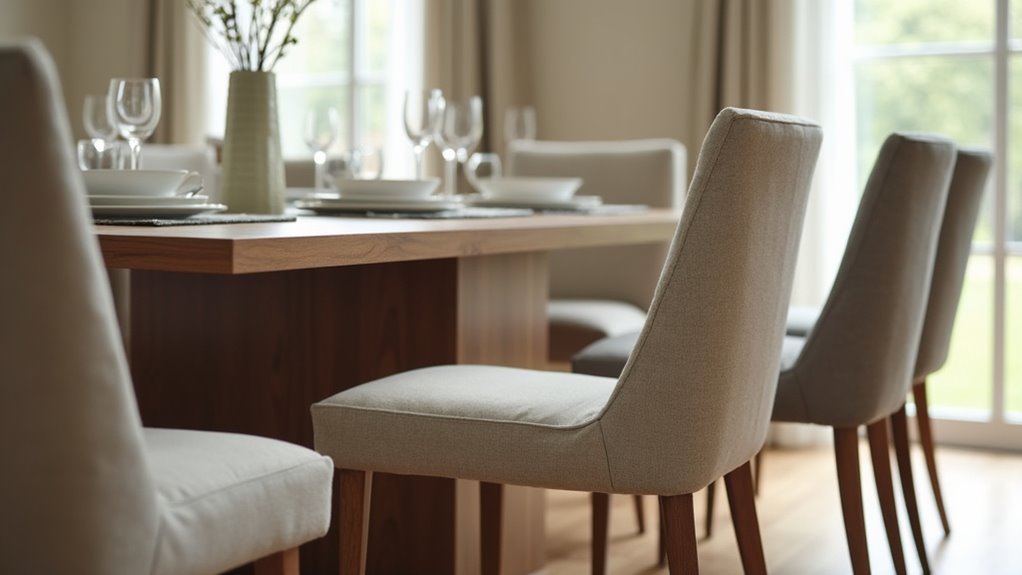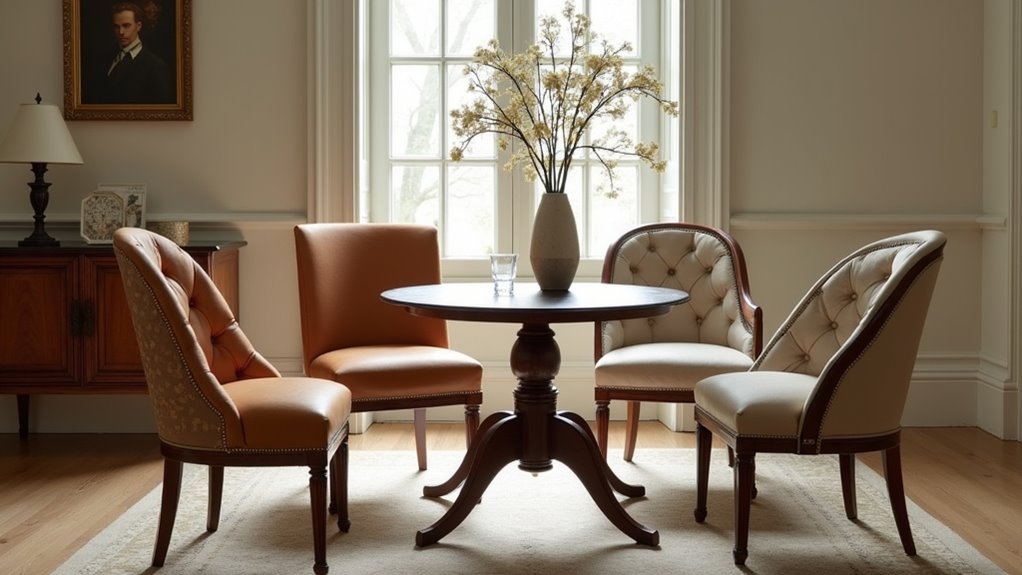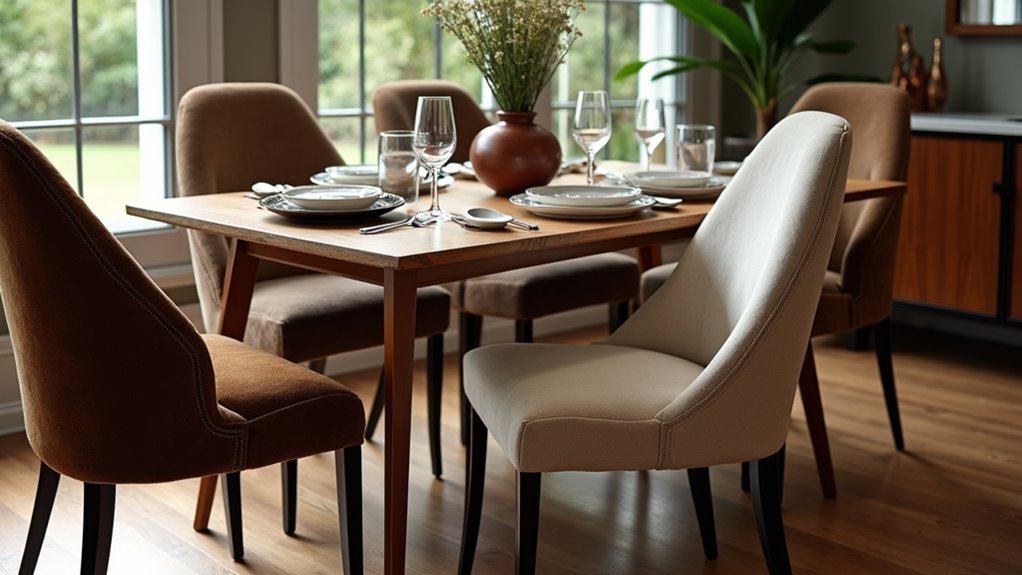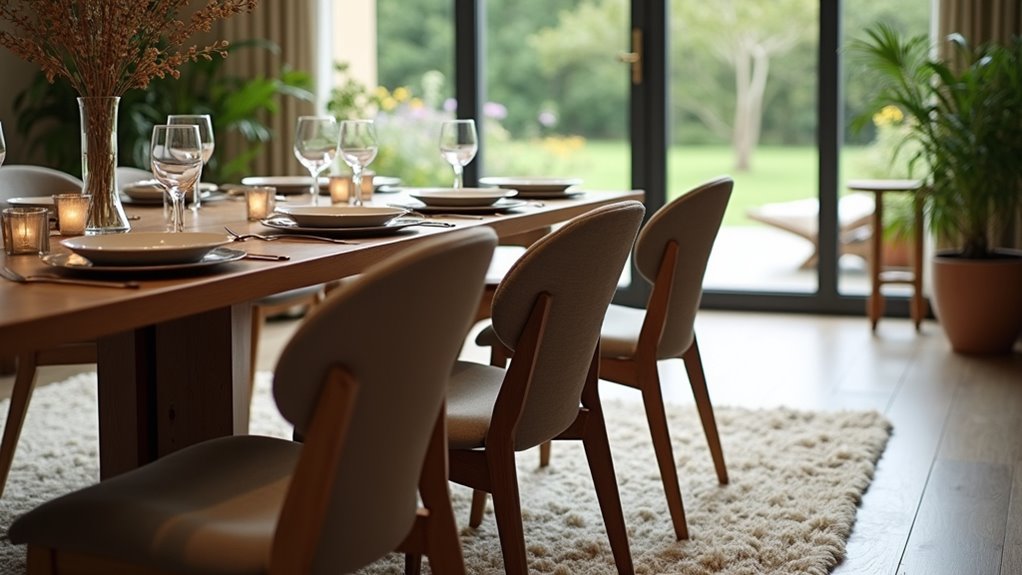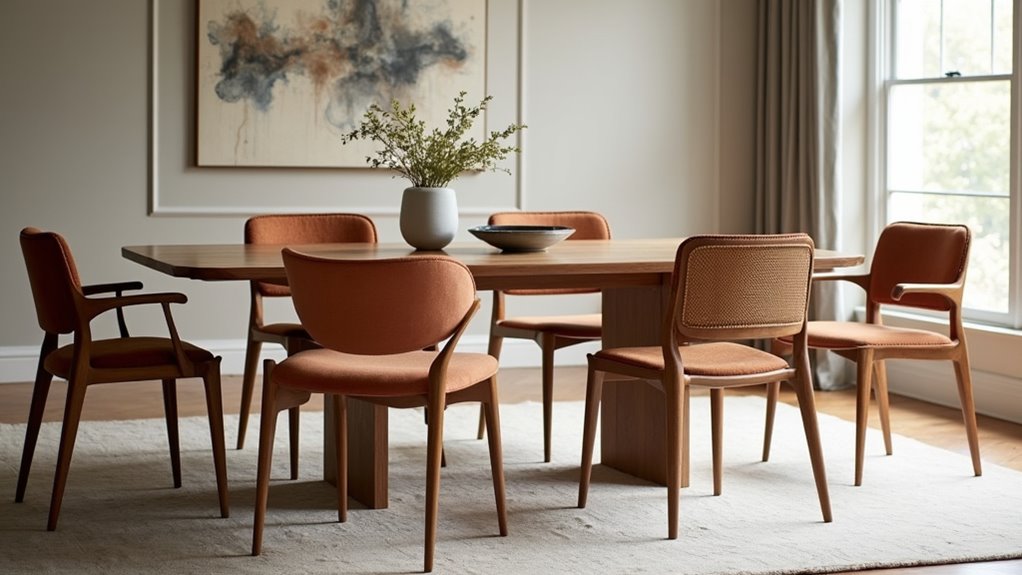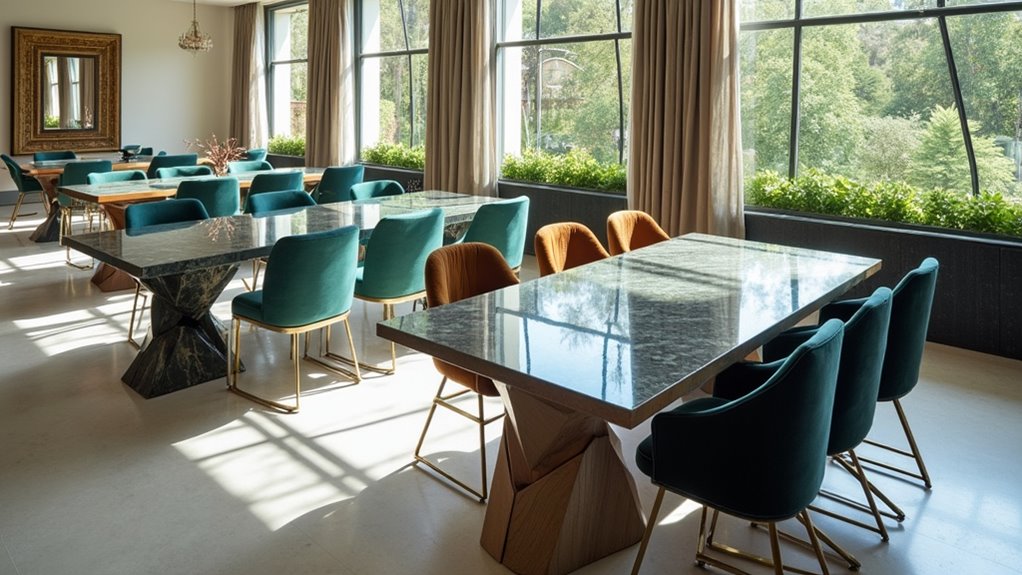Dining chair backs significantly influence both comfort and style in any dining area. Slat back designs offer timeless elegance, while ladder backs bring rustic charm. Cross backs can feature distinctive crisscross designs for a touch of personality, whereas splat backs provide structure with artistry. For a cozy ambiance, wingback chairs cradle diners in comfort. Keyhole chairs introduce a unique cutout aesthetic. Modern inspirations often fuse sleek lines with vibrant colors, enhancing the overall appeal—discover more intriguing options to elevate your dining experience.
Key Takeaways
- Cross Back Chairs feature a distinctive crisscross design, combining ergonomic support with a rustic aesthetic, perfect for diverse dining spaces.
- Wingback Chairs provide high backs and side wings for exceptional comfort, making them ideal for long meals and adding a focal point to dining areas.
- Keyhole Chairs incorporate unique cutouts for an airy, stylish look, constructed from durable materials and suitable for both modern and classic interiors.
- Splat Back Chairs offer artistic appeal with their central slat designs, promoting comfort and posture during dining, fitting in traditional and transitional styles.
- Curved Backchairs align with contemporary trends, featuring gentle contours that enhance comfort while introducing visual softness and inviting relaxation to dining spaces.
Slat Back Chairs

Although slat back chairs have evolved through centuries of design, they retain a timeless appeal that transcends fleeting trends. Originating in Europe during the 15th century, slat back history showcases a remarkable journey, flourishing in the 17th and 18th centuries as refined styles emerged in colonial America. These chairs, characterized by their vertical slats and clean lines, are primarily crafted from solid woods like oak and cherry, providing both durability and aesthetic warmth. Slat back chairs’ clean, rectilinear aesthetics may also include metal for a modern twist, reflecting versatility across various design styles. The ergonomic backrest supports comfort, making slat back chairs an exquisite blend of history and contemporary utility, adaptable to both rustic settings and chic, modern spaces. Their functionality: size relative to dining table height ensures they fit seamlessly into diverse dining environments. The craftsmanship with high-quality materials, evident in some iconic chair designs such as Hans J. Wegner’s Wishbone Chair, also enhances the allure of modern slat back chairs.
Ladder Back Chairs
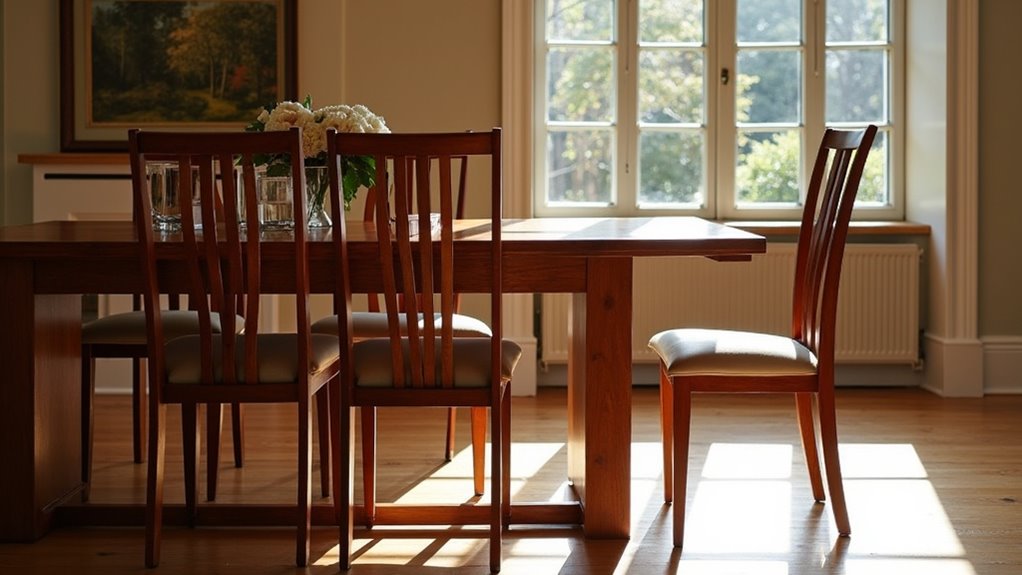
From the rich lineage of chair design, ladder back chairs emerge as an enduring and practical choice, captivating both history enthusiasts and modern decorators alike. Originating in the Middle Ages and popularized in 17th-century England, these chairs transitioned from humble peasant origins to esteemed pieces in colonial America.
Their defining features include horizontal slats resembling a ladder and elegantly turned posts, crafted using traditional techniques like mortise and tenon joints. Early examples sported rush or cane seats, while contemporary adaptations explore diverse materials like metal and upholstery.
Emphasizing versatility, ladder back chairs harmonize with various design aesthetics, from rustic to modern, proving their timelessness in enhancing both comfort and style in any space.
Cross Back Chairs

Cross back chairs epitomize a harmonious blend of functional design and aesthetic appeal, originating from the charming cafes of early 20th-century France. The distinctive crisscross back not only enhances ergonomic support but also exemplifies cross back durability, making these chairs a smart investment. Their design has evolved, allowing for cross back versatility that complements various interior styles—from rustic farmhouse to modern elegance. Additionally, these chairs can be integrated into mismatched seating arrangements for a personalized dining environment that reflects individual taste.
| Material | Durability | Common Application |
|---|---|---|
| Solid Oak | High | Home dining rooms |
| Beechwood | Moderate | Cafes and restaurants |
| Metal (Steel) | Very High | Outdoor events and venues |
| Rattan | Moderate | Event styling |
| Upholstered | Varies | Comfortable seating |
Splat Back Chairs
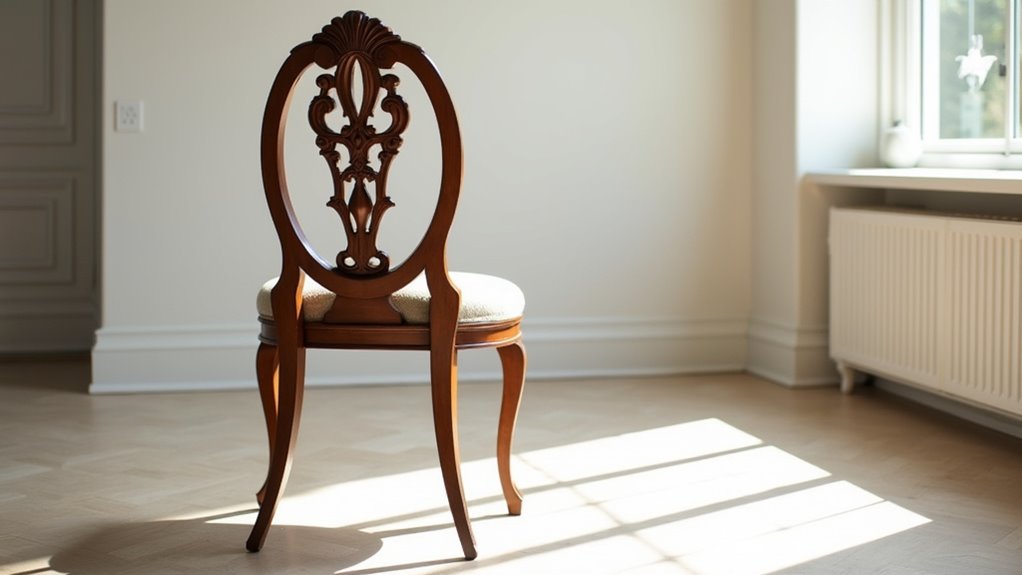
Splat back chairs embody a timeless elegance, distinguished by their iconic central slat that provides both structural integrity and aesthetic allure. This design is a hallmark of various styles, reflecting its historical significance through splat variations, such as:
- Fiddle Back: A graceful, violin-shaped splat captured in classic designs.
- Vase-Shaped: Elegantly mimics a silhouette of a vase, offering visual harmony.
- Pierced Splat: Showcases intricately cut patterns, enhancing lightness and visual interest.
Predominantly crafted from durable hardwoods, these chairs utilize diverse construction techniques, allowing for both robust support and artistic expression. Their versatility makes splat back chairs an ideal choice for traditional, farmhouse, or transitional spaces, elegantly bridging eras and styles in dining aesthetics. A key feature of these chairs is their ergonomic design, which promotes comfort and improved posture during dining experiences.
Wingback Chairs
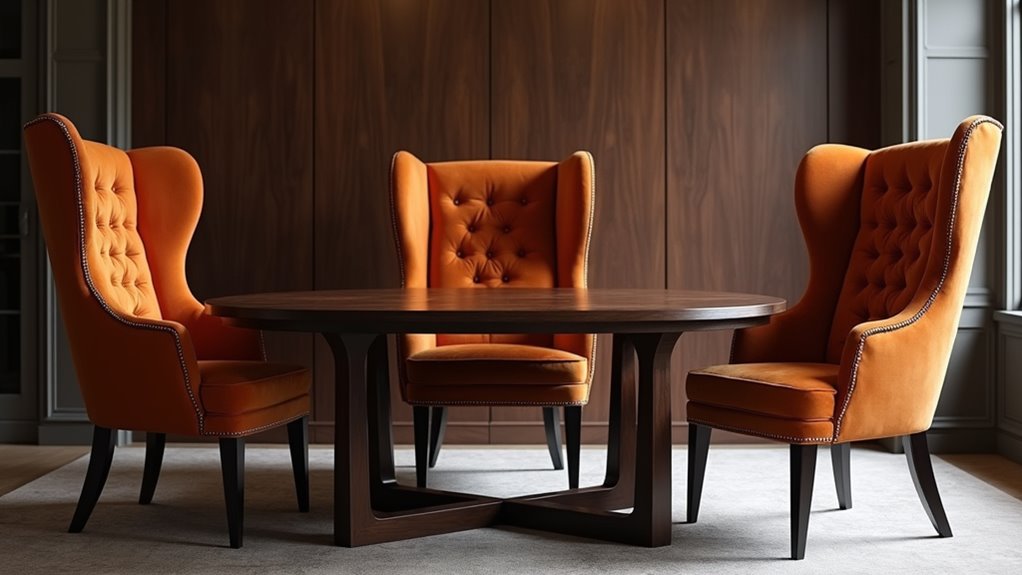
Wingback chairs, emerging in 17th-century England as elegant solutions to chilly drafts, seamlessly blend historical significance with modern comfort. Their high backs and distinctive wings cradle the body, providing not just support but a cozy sanctuary during long meals. Today, these chairs enhance dining spaces with their versatile styles, effortlessly becoming focal points that invite both connection and conversation. Additionally, selecting dining chairs with high-density foam ensures lasting comfort and ergonomic support, enhancing the dining experience over time.
Historical Design Origins
In the realms of furniture design, the wingback chair stands as a testament to both function and artistry, emerging from the cold, drafty spaces of 17th-century England.
Initially designed to fend off the chill of large rooms, its “wings” served a vital purpose, adapting through historical influences to meet evolving needs.
- Originally crafted from wood, these chairs transitioned over time, embracing full upholstery.
- The Queen Anne period greatly influenced its design, favoring simple curves and minimal ornamentation.
- Renowned furniture makers, like Thomas Chippendale, refined the wingback, enhancing its elegance and comfort.
This evolution showcases how the wingback chair evolved from utilitarian necessity to an iconic piece of artistry, seamlessly blending comfort and style through the ages.
Comfort and Support
Comfort transcends mere aesthetics in the realm of wingback chairs, where thoughtful design meets user well-being.
These chairs provide exceptional ergonomic benefits, with high back support and integrated lumbar support that align with the natural curve of the spine. This thoughtful construction encourages an upright posture, reducing strain on the neck and back, making them ideal for prolonged sitting.
The unique wings create a cocoon-like environment, enhancing comfort while also offering head and neck support. Ample padding and diverse upholstery options further contribute to a plush seating experience, ensuring no pressure points disrupt relaxation.
Styling in Dining Spaces
When selecting wingback chairs for a dining space, the thoughtful interplay of style and functionality becomes paramount, effortlessly elevating both aesthetics and usability. The grandeur and distinctive silhouette of these chairs enhance dining decor while providing comfortable seating.
Proper chair placement is crucial; strategically positioning wingback chairs at the ends of the table achieves visual balance and formality.
- Pair with simpler side chairs for contrast and to prevent overwhelming the space.
- Opt for complementary colors to harmonize with the room’s palette, creating cohesion.
- Choose durable fabrics that withstand the rigors of dining while adding texture and warmth.
Incorporating these elements ensures a sophisticated dining environment that reflects personal style and enhances guest experience.
Keyhole Chairs

Keyhole chairs capture attention with their distinctive backrests, characterized by an open cutout that resembles a keyhole. This thoughtful design element, rooted in keyhole history, showcases meticulous chair craftsmanship and lends an airy quality to dining spaces.
The varying shapes of cutouts—from circular to elongated oval—prevent bulkiness while providing visual intrigue. Traditionally constructed from robust materials such as rubberwood and oak, these chairs offer durability alongside aesthetic appeal.
Upholstery options abound, ranging from plush velvet to sleek polyester blends, ensuring comfort for extended dining experiences. With their high backrests and sturdy frames, keyhole chairs not only enhance style but also deliver functional benefits, making them an excellent choice for both contemporary and classic interiors.
Modern Design Inspirations
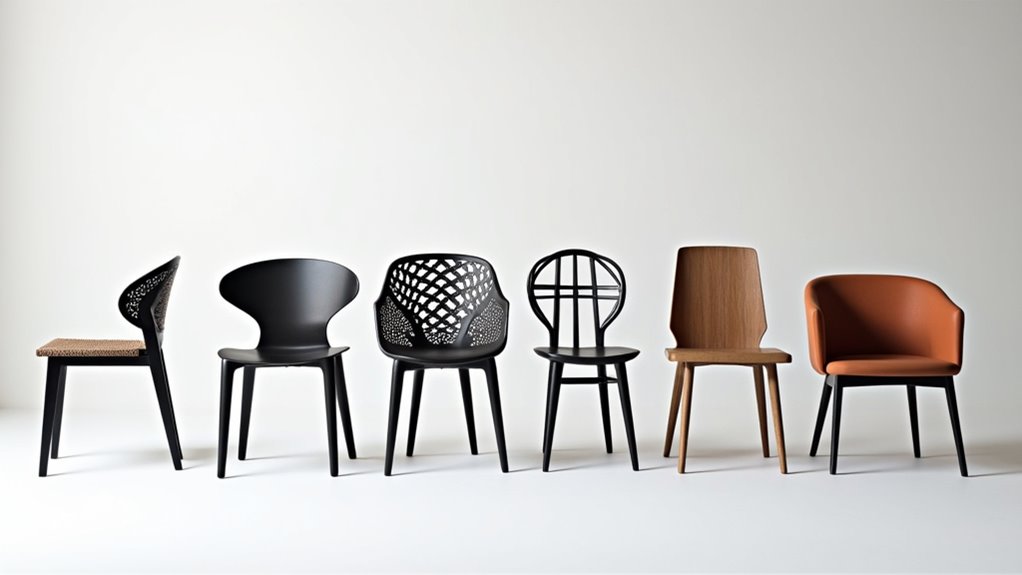
Modern design inspirations for dining chair backs showcase a striking blend of minimalist aesthetics and streamlined shapes, creating an inviting yet sophisticated presence.
Bold colors emerge as focal points, offering unexpected vibrancy against the understated elegance of their forms.
This harmonious fusion elevates dining spaces, transforming them into reflections of contemporary artistry.
Minimalist Aesthetics
Embracing a philosophy of simplicity and functionality, minimalist aesthetics in dining chair backs redefine modern design by stripping away excess while celebrating form and material.
These designs champion minimalist comfort through sleek silhouettes that blend seamlessly into various dining environments. The subtle artistry of low-back silhouettes offers elegance without clutter, while innovative geometric and sculptural forms turn seating into striking visuals.
- Cantilevered designs introduce unique flexibility and charm.
- Transparent “ghost” chairs enhance openness and lightness.
- Material-forward backs emphasize the intrinsic beauty of wood and metal.
In this way, minimalist aesthetics cultivate an inviting space that balances sophistication with practicality, ensuring that every dining experience is both visually pleasing and highly comfortable.
Streamlined Shapes
In the realm of contemporary design, streamlined shapes have emerged as a captivating evolution of dining chair backs, reflecting a shift towards softer, more organic forms.
Curved silhouettes dominate this trend, effortlessly blending aesthetic appeal with functional comfort. These gently sculpted backrests are thoughtfully crafted to follow the natural contours of the spine, enhancing the ergonomic designs of modern dining spaces.
The flowing lines create an atmosphere of visual softness, inviting relaxation and conversation around the table. Moreover, these curved chairs harmonize beautifully with round tables, fostering a cohesive design that feels both elegant and inviting.
As the world gravitates toward simplicity and comfort, streamlined shapes redefine dining chair backs, marrying contemporary artistry with everyday usability.
Bold Colors
Vibrant hues in dining chair design breathe life into culinary spaces, transforming them from mere eating areas into lively gathering spots. The infusion of bold colors evokes various emotions, making them essential elements in modern design.
Whether it’s a striking red that ignites the atmosphere or a calming blue that nurtures relaxation, bold chair designs are integral in defining a room’s aesthetic.
- Earthy greens connect spaces with nature, fostering serenity.
- Rich jewel tones like emerald and sapphire bring an opulent touch.
- Mixing vibrant color combinations allows for personal expression without overwhelming the space.


